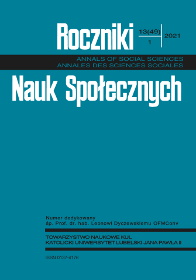The Media Commandments of Father Professor Leon Dyczewski and Marketing Communication
Abstract
The article refers to the principles of “appropriate attitude to the media” formulated by Father Professor Leon Dyczewski to contemporary marketing communication: advertising and public relations. In line with his recommendations, the issue of media education was taken up in relation to the knowledge and competence of advertising reception. Based on the research by Seth Ashley and colleagues a scale for measuring media literacy was developed, with particular emphasis on content creation techniques and reception of advertising. The model includes elements of knowledge measurement about 1) the ways in which media outlets effectively reach their audience, 2) messages & meanings of advertising, and 3) advertising representations and reality. The scale of Ashley and colleagues was extended to include additional media literacy measures. Two new components have been added: measures for self-assessment of media literacy (subjective media literacy) and the importance that receivers attach to media literacy.
References
Ashley, S., Poepsel, M., Willis, E. (2010). Media literacy and news credibility: Does knowledge of media ownership increase skepticism in news consumers?, Journal of Media Literacy Education, nr 2, s. 37-46.
Buijzen M., Valkenburg P.M. (2003), The effects of television advertising on materialism, parent-child conflict, and unhappiness: A review of research, Journal of Applied Developmental Psychology, nr 24(4), s. 437-456.
Calvert S.L. (2008), Children as consumers: Advertising and marketing, The Future of Children nr 18(1), s. 205-234.
Chu M.T., Blades M., Herbert J. (2014), The development of children’s scepticism about advertising, [w:] M. Blades, C. Oates, F. Blumberg, B. Gunter (red.), Advertising to children, London: Palgrave Macmillan, s. 38-49.
Czapla T.P. (2016), Logika kształtowania kompetencji – porównanie podejścia klasycznego i zintegrowanego, Zeszyty Naukowe Uniwersytetu Ekonomicznego w Krakowie, nr 6(954), s. 81-94.
Duda A. (2018), Medialne socjotechniki brandcastingu. Hybrydyzacja, uwiarygadnianie, zadaniowość, Lublin: Wydawnictwo KUL.
Dyczewski L. (2005), Konieczność kompetencji medialnej w rodzinie, [w:] L. Dyczewski (red.), Rodzina, dziecko, media, Lublin: Wydawnictwo KUL, s. 332-349.
Dyczewski L. (2009a), Wstęp, [w:] L. Dyczewski (red.), Jaka informacja?, Lublin–Warszawa: Wydawnictwo KUL, Centrum Europejskie Natolin, s. 7-9.
Dyczewski L. (2009b), Kryteria rzetelnej informacji, [w:] L. Dyczewski (red.), Jaka informacja?, Lublin–Warszawa: Wydawnictwo KUL, Centrum Europejskie Natolin, s. 25-32.
Dyczewski L. (2012), Konieczność kompetencji medialnych w nowoczesności, [w:] A. Sugier-Szerega, M. Sławek-Czochra, Konieczność i różnorodność kompetencji medialnej, Lublin: Wydawnictwo KUL, s. 9-20.
Dyczewski L. (2016), 10 przykazań właściwego stosunku do mediów, Niedziela Ogólnopolska”, nr 9, s. 28, https://www.niedziela.pl/artykul/123280/nd/10-przykazan-wlasciwego-stosunku-do [dostęp: 17.01.2021].
Hobbs R. (2010), Digital and media literacy: A plan of action, Washington: The Aspen Institute Publications Office.
Jacobson M.F., Mazur L.A., Nader R. (2019), Marketing madness. A survival guide for a consumer society, New York: Routledge.
Kahne J., Lee N., Feezell J.T. (2012), Digital media literacy education and online civic and political participation, International Journal of Communication, nr 6, s. 1-24.
Klein N. (2018), NIE to za mało. Jak stawić opór polityce szoku i stworzyć świat, jakiego nam trzeba, Warszawa: Muza.
Lindstrom M. (2005), Dziecko reklamy, Warszawa: Świat Książki.
Maksl A., Ashley S., Craft S. (2015), Measuring news media literacy, Journal of Media Literacy Education, nr 6(3), s. 29-45.
McGuigan J. (1992), Cultural populism, London: Routledge.
Mihailidis P. (2009), The first step is the hardest: Finding connections in media literacy education, Journal of Media Literacy Education, nr 1(1), s. 53-67.
Neff J. (2014), Ten years in, Dove’s “Real Beauty” seems to be aging well, AdAge, January 22, http://adage.com/article/news/ten-years-dove-s-real-beauty-aging/291216 [dostęp: 15.01.2021].
Obuchowski K. (2001), W poszukiwaniu właściwości człowieka, Poznań: Garmond.
Potter J.W. (2004), Theory of media literacy: A cognitive approach, Thousand Oaks, CA: Sage.
Primack B.A., Gold M.A., Switzer G.E., Hobbs R., Land S.R., Fine M.J. (2006), Development and validation of a smoking media literacy scale for adolescents, Archives of Pediatrics and Adolescent Medicine, nr 160(4), s. 369-374.
Ptaszek G. (2019), Edukacja medialna 3.0. Krytyczne rozumienie mediów cyfrowych w dobie Big Data i algorytmizacji, Kraków: Wydawnictwo Uniwersytetu Jagiellońskiego.
Samek M. (2010), Zmierzch ery konsumenckiej. Prosument w komunikacji marketingowej, [w:] M. Wierzchoń, J. Orzechowski (red.), Nowe trendy w reklamie. Między nauką a praktyką, Warszawa: Wydawnictwo SWPS Academica, s. 175-197.
Schor J. (2004), Born to buy: The commercialized child and the new consumer culture, New York: Scribner.
Weaver S.T., Moschis G.P., Davis T. (2011), Antecedents of materialism and compulsive buying: A life course study in Australia, Australasian Marketing Journal, nr 19(4), s. 247-256.
Copyright (c) 2021 Roczniki Nauk Społecznych

This work is licensed under a Creative Commons Attribution-NonCommercial-NoDerivatives 4.0 International License.


